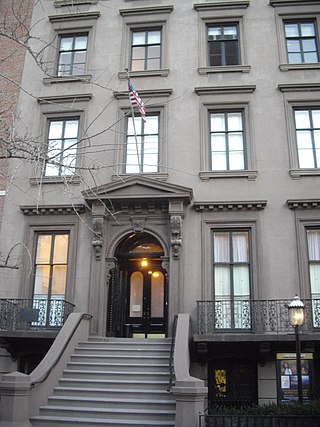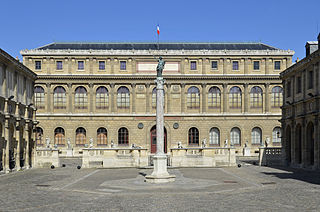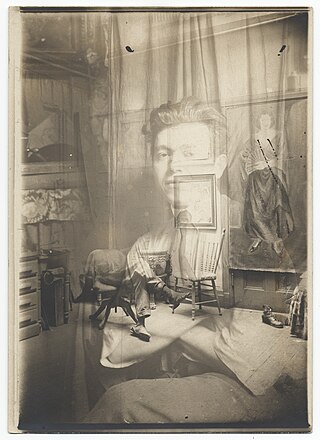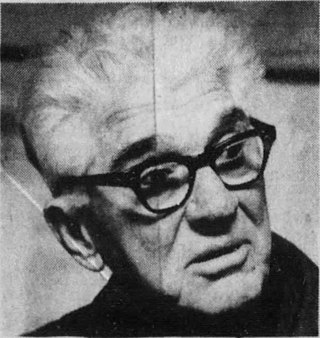
Visual art of the United States or American art is visual art made in the United States or by U.S. artists. Before colonization, there were many flourishing traditions of Native American art, and where the Spanish colonized Spanish Colonial architecture and the accompanying styles in other media were quickly in place. Early colonial art on the East Coast initially relied on artists from Europe, with John White the earliest example. In the late 18th and early 19th centuries, artists primarily painted portraits, and some landscapes in a style based mainly on English painting. Furniture-makers imitating English styles and similar craftsmen were also established in the major cities, but in the English colonies, locally made pottery remained resolutely utilitarian until the 19th century, with fancy products imported.

Max Weber was a Jewish-American painter and one of the first American Cubist painters who, in later life, turned to more figurative Jewish themes in his art. He is best known today for Chinese Restaurant (1915), in the collection of the Whitney Museum of American Art, "the finest canvas of his Cubist phase," in the words of art historian Avis Berman.

The National Academy of Design is an honorary association of American artists, founded in New York City in 1825 by Samuel Morse, Asher Durand, Thomas Cole, Martin E. Thompson, Charles Cushing Wright, Ithiel Town, and others "to promote the fine arts in America through instruction and exhibition." Membership is limited to 450 American artists and architects, who are elected by their peers on the basis of recognized excellence.

William Merritt Chase was an American painter, known as an exponent of Impressionism and as a teacher. He is also responsible for establishing the Chase School, which later became the Parsons School of Design.
Frank Joseph Reilly (1906–1967) was an American painter, illustrator, muralist, and teacher. He taught drawing and painting at the Grand Central School of Art, and illustration at Pratt Institute and Moore College of Art. However, he is best known for his twenty-eight years of instructing at the Art Students League of New York and establishing the Frank J. Reilly School of Art in the early 1960s, where he taught until his death in 1967.

The Art Academy of Cincinnati is a private college of art and design in Cincinnati, Ohio. It was founded as the McMicken School of Design in 1869, and was a department of the University of Cincinnati, and later in 1887, became the Art Academy of Cincinnati, the museum school of the Cincinnati Art Museum. The college is accredited by the National Association of Schools of Art and Design.

John D. Graham was a Ukrainian–born American modernist and figurative painter, art collector, and a mentor of modernist artists in New York City.

Knox Martin was an American painter, sculptor, and muralist.
The Grand Central School of Art was an American art school in New York City, founded in 1922 by the painters Edmund Greacen, Walter Leighton Clark and John Singer Sargent. It closed in 1944.

The Salmagundi Club, sometimes referred to as the Salmagundi Art Club, is a fine arts center founded in 1871 in the Greenwich Village section of Manhattan, New York City. Since 1917, it has been located at 47 Fifth Avenue. As of 2021, its membership roster totals roughly 1,250 members.

École des Beaux-Arts refers to a number of influential art schools in France. The term is associated with the Beaux-Arts style in architecture and city planning that thrived in France and other countries during the late nineteenth century and the first quarter of the twentieth century.

Jan Matulka was a Czech-American modern artist originally from Bohemia. Matulka's style ranged from Abstract expressionism to landscapes, sometimes in the same day. He has directly influenced artists like Dorothy Dehner, Francis Criss, Burgoyne Diller, I. Rice Pereira, and David Smith.

Allen Tucker (1866–1939) was an American artist.

Tania was a Polish-born Jewish American abstract painter, sculptor, collage artist and painter of city walls.

Wilhelmina Weber Furlong was a German American artist and teacher.
Tomás (Tomas) Furlong (1886–1952) was an American artist and teacher.
Golden Heart Farm is a private residence in the hamlet of Bolton Landing, New York, in the United States. It served as the art colony of Thomas and Weber Furlong from 1921 to 1962. Artists from Manhattan came to the art colony to study with Wilhelmina Weber Furlong of the Art Students League of New York

Vaclav Vytlacil was an American artist and art instructor. He was among the earliest and most influential advocates of Hans Hofmann's teachings in the United States.















